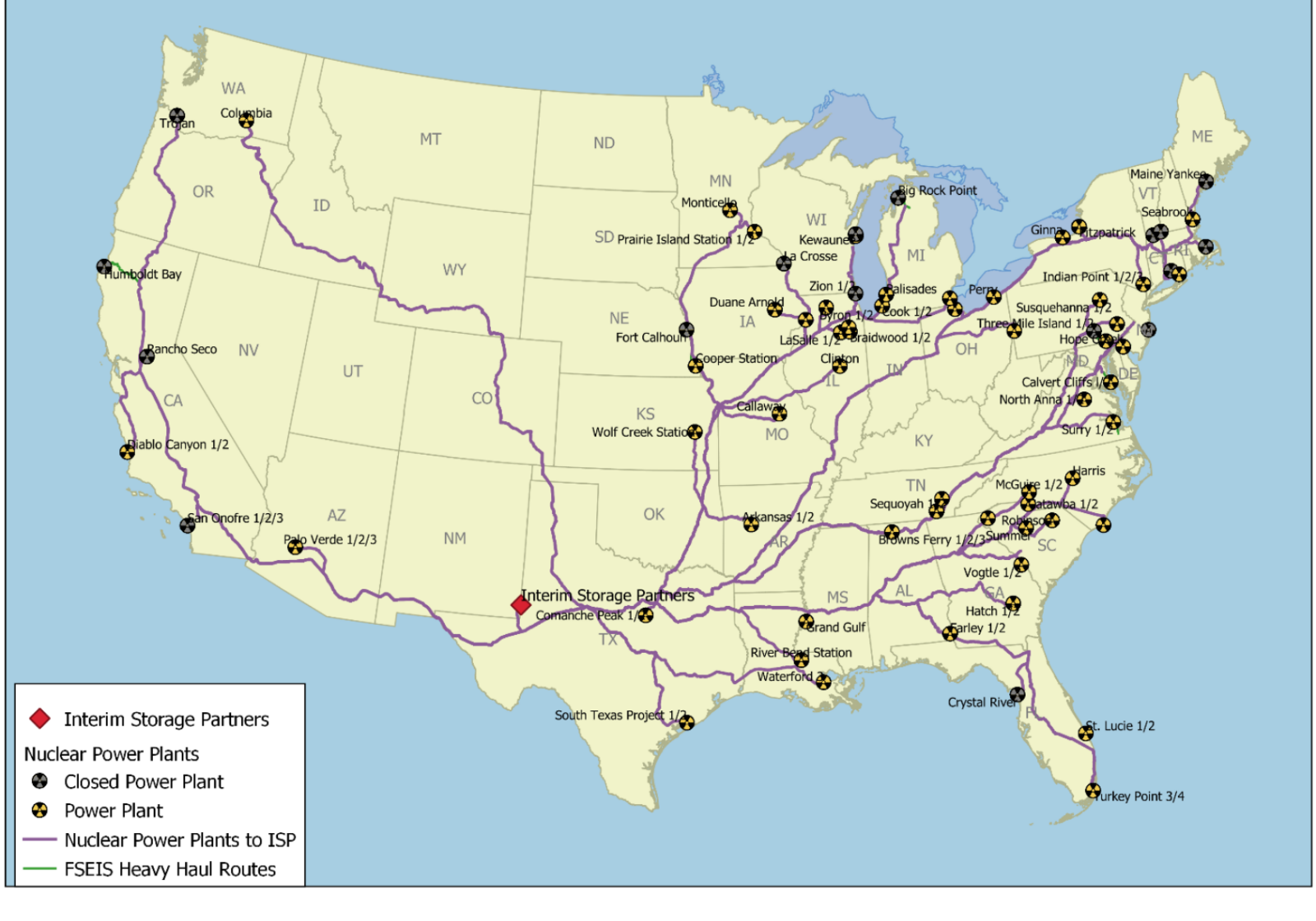DOE keen to downplay Mobile Chornobyl risks, yet again

[Image: The Western Interstate Energy Board (WIEB) submitted the map, above, as official public comments on the Interim Storage Partners, LLC (ISP) Draft EIS in Nov. 2020. It shows the most likely rail transport routes to haul irradiated nuclear fuel from nuclear power plants, to the proposed highly radioactive waste consolidated interim storage facility (CISF) targeted at Waste Control Specialists, LLC, in Andrews County, Texas. WIEB used DOE’s own computer modeling to determine these most likely shipping routes. The company and U.S. Nuclear Regulatory Commission (NRC) did their darndest to keep the routing secret, so as to not alert residents along the train tracks, a disproportionate percent of which are low-income and/or Black, Indigenous, People of Color communities. Note that routes to Holtec’s CISF — which is targeted just 40-some miles to the west of ISP’s — would be very similar, and have also been kept very secretive.]
{This just in: At 11am ET, Thursday, August 22, 2024, DOE announced a “WEBINAR: Learn More about DOE’s Package Performance Demonstration (PPD) Request For Information (RFI) – Key Insights & Next Steps.” It is scheduled for Tuesday, August 27, 2024, from 11am to 12pm ET. Pre-registration is required. Learn more detail about this “Informational Webinar,” here.}
Below is the text of an email sent out on July 31, 2024 by the U.S. Department of Energy (DOE)/Office of Nuclear Energy/Spent Fuel & High-Level Waste Disposition, to subscribers to its so-called but insincere to the point of Orwellian “Consent-Based Siting” email list.
DOE has, for decades, attempted to downplay the high risks of transporting highly radioactive wastes, including commercial irradiated nuclear fuel. So too have NRC, industry, and their allies.
The environmental and EJ movements have pushed back that whole time, as has the State of Nevada Agency for Nuclear Projects — as Nevada was targeted for the national dump, on Western Shoshone land at Yucca Mountain. This meant that every since shipment of high-level radioactive waste would pass through Nevada, en route to Yucca.
Thankfully, through tremendous, tireless resistance, the Yucca dump is currently cancelled — although Republicans are still trying to resurrect the scheme. This includes mention in Donald Trump and the Heritage Foundation’s “Project 2025,” which not only advocates for resuming the Yucca Mountain Project, but also for restarting full-scale nuclear weapons testing at the Nevada Test Site immediately next door. Full-scale nuclear weapons testing ended there in September 1992, although sub-critical testing (plutonium embedded in high explosives) has continued — the data generated is fed into supercomputers to continue to “advance” nuclear weapons designs.
The U.S. Nuclear Regulatory Commission previously proposed a full-scale package performance demonstration, decades ago. A concerted effort by an environmental coalition, to take part in the planning, ended with a slap in the face — NRC simply cancelled proceeding, after many months and even years of public engagement, all for naught.
Clearly, our environmental and anti-nuclear coalition will have to engage again, if for no other reason than to watch-dog and resist DOE (and industry, and NRC) propaganda efforts to downplay the high risks of irradiated nuclear fuel and high-level radioactive waste transportation.
TEXT OF DOE’S JULY 31, 2024 EMAIL:
DOE Seeks Input on Spent Nuclear Fuel Transportation Safety Demonstration
Request for information responses due Sept. 30, 2024
The U.S. Department of Energy (DOE) has issued a request for information (RFI) to gather input on a proposed package performance demonstration (PPD) to show the robustness of spent nuclear fuel transportation casks in hypothetical accident conditions.
By simulating severe accident scenarios, DOE intends to demonstrate to the public and stakeholders the safety and reliability of transporting spent nuclear fuel by rail, heavy-haul truck, and barge.
DOE is seeking information from a wide range of stakeholders, including government partners, the general public, industry experts, and potential suppliers.
Key Objectives
- Build Public Trust: The PPD aims to address public concerns regarding the safety of transporting spent nuclear fuel by rail, heavy-haul truck, and barge.
- Comprehensive Input: Stakeholder feedback is sought on the types of full-scale demonstrations to be conducted, the selection of spent nuclear fuel transportation casks, potential testing facilities, and how information from the PPD can be used.
- Supplier Engagement: DOE is requesting detailed information from potential suppliers regarding equipment and services necessary for the PPD, including cask vendors, testing facilities, and providers of instrumentation and videography services.
Interested parties are invited to submit their responses electronically by 6 PM PST, Sept. 30, 2024.
Responses to the RFI will be used to design the PPD so it effectively addresses public concerns and demonstrates the safety of spent nuclear fuel transportation casks.
DOE is implementing a consent-based siting process to identify sites for one or more federal consolidated interim storage facilities for the nation’s spent nuclear fuel. This will involve large-scale transportation of spent nuclear fuel from over 70 nuclear power plant sites, with rail being the primary mode of transport.
DOE plans to increase its outreach and engagement activities, including webinars, listening sessions, and working groups, to raise awareness about the transportation of spent nuclear fuel.
For more information on this RFI and directions on how to submit responses, please visit the FedConnect listing.
Support Beyond Nuclear
Help to ensure a safer, greener and more just world for all

